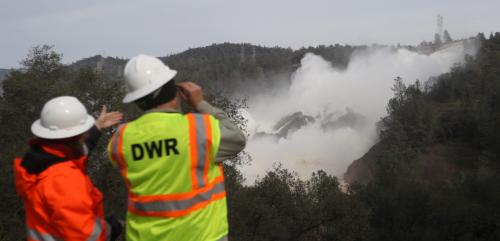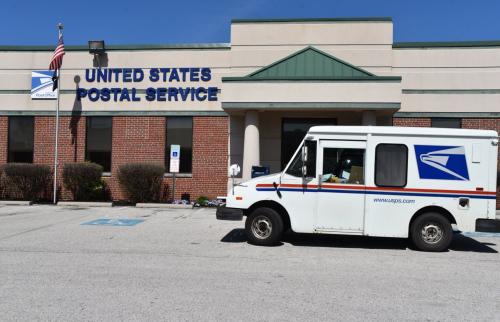The recent collapse of the Francis Scott Key bridge in Baltimore after being struck by a container ship is both a human tragedy and an economic disaster. Six construction workers doing repair work on the bridge lost their lives when it plunged into the cold Patapsco River. The wreckage of the bridge now sits in the channel that connects Baltimore Harbor to the Chesapeake Bay, effectively closing the Port of Baltimore. Joe Kane, a fellow in Brookings Metro, talks about the economic impacts of the disaster and prospects for rebuilding the bridge.
Transcript
DEWS: This is The Current, part of the Brookings Podcast Network. I’m your host, Fred Dews.
The recent collapse of the Francis Scott Key Bridge in Baltimore after being struck by a container ship is both a human tragedy and an economic disaster. Six construction workers doing repair work on the bridge span in the early morning hours lost their lives when the bridge plunged into the cold Patapsco River. They were immigrants from Mexico, Guatemala, Honduras, and El Salvador.
The wreckage of the bridge now sits in the channel that connects Baltimore Harbor to the Chesapeake Bay, effectively closing the Port of Baltimore. Here to talk about the impacts of that closure on our economy and prospects for rebuilding the bridge is Joe Kane, a fellow in Brookings Metro. Joe, welcome back to The Current.
KANE: Thanks for having me, Fred.
DEWS: So, Joe, the last time I interviewed you was for the Brookings Cafeteria podcast about six years ago on your report about America’s water infrastructure and water workers. Now you’re here to talk about something else related to water: America’s ports, and specifically Baltimore.
So, first, can you put the port of Baltimore into context, like its size relative to other US ports along the East Coast and elsewhere?
KANE: Yeah, I mean look, so there’s a lot of attention being paid towards this because of the bridge collapse and the disruption to both passenger and freight traffic in and around Baltimore. And the Port of Baltimore, it’s not the largest port on the East Coast. I mean, that’s obviously the Port of New York and New Jersey, but it is one of the largest and most significant. I mean, on an annual basis, there are about 50 million tons of goods valued at about $80 billion that go to and from the port each year. That ranks within the top 20 in terms of tonnage nationally. It’s actually within the top 10 in terms of of value.
But then digging even deeper into that, particular products passing through the port, including automobiles in particular, it’s the top port for for auto goods and transportation equipment actually. But there’s other goods too. It’s actually a major port for coal exports, it’s also important for coffee and sugar. So, I mean, many different goods do depend on the port of Baltimore. And then obviously, you know, with this bridge collapse and the disruptions to traffic, I mean, there’s a lot of concerns as to what those economic ripple effects could be.
DEWS: So, what do you think are some of the short term, perhaps, economic impacts that this will have and even some in the medium to longer term?
KANE: Yeah, so I mean look the bridge itself, it’s part of I-695, so it’s one of three crossings throughout the Baltimore region. There’s the I-95 and I-895 tunnels, but it handled about 15% or so of the bridge traffic throughout the region. So, you know, not nothing, but, you know, not obviously the biggest.
And so, in the short term the immediate just disruptions of course to the port itself as we were just talking about, but then to the distribution facilities nearby too. I mean, there’s Amazon, FedEx, Under Armour, you know, VW, BMW. I mean, there are many other distribution facilities in the region too, beyond the actual port itself.
And so, the disruptions that it’s going to have for passenger vehicles, you know, 30, 35,000 vehicles a day, about 12 million vehicles a year used the bridge. So, I mean, that’s going to cause some diversions in terms of where’s all that traffic going to go. And some of that traffic can go on those other crossings I just mentioned of I-95 and I-895, but others really can’t. I mean, I know vehicles with hazardous materials, for example, are restricted from some of those tunnel crossings.
And so, you know, you’re talking potentially 10, 20 additional miles if not longer for some of those vehicles. So, think of costs in terms of delays, in terms of diversions, you know. And there’s kind of a short-term element to that and a potential medium- to long-term element, you know, six months, a year, who knows, right? Cause there’s still a lot of unknowns as to the ultimate timeline here of repairing the bridge.
DEWS: Now we’ve seen some video of some of the big container ships stacking up, I guess out in the Chesapeake Bay outside of the Port of Baltimore itself. Are there alternatives for those kinds of ships? I mean, can they go up to New York, New Jersey? Can they go down to Jacksonville, go to the port of Virginia?
KANE: They can, and some of them actually already are. So, Port of Baltimore, again, is a major, major port. So, it’s not like a light switch you can just turn on and off, you know. It’s part of an extensive freight and distribution network, both domestically, but also globally. Part of extensive value chains for local manufacturers and other retailers and to say nothing of households and businesses that depend on this traffic. But we are actually already seeing some ships going to Port of Virginia, so towards Norfolk and the Hampton Roads region in Virginia, about, you know, 150 to 200 miles south of where Baltimore is.
An important aspect that a lot of people don’t talk about is Baltimore is actually, among East Coast ports, it’s the closest geographically to the Midwest. So, so even if some of that traffic is diverted to other East Coast ports—you know, Philly might be and then obviously, Port of New York, New Jersey—it doesn’t change the fact that Baltimore still has a strategic location in terms of our freight networks to reaching some of those inland destinations too. So, just because the vessel and container traffic might be shifting on the coast, doesn’t change the fact that truck traffic in particular has to go in different routes to inland. And so that’s just something to bear in mind as obviously all this is unfolding in real time.
DEWS: You talk about flipping a light switch and you talk about value chains. I mean, the port of Baltimore and the other ports are all part of an interconnected network of a supply chain that is probably very precise. And if it’s disrupted, even in one location, it’s going to have ripple effects throughout the supply chain, throughout the economy, right?
KANE: That’s right. I mean, look, there’s sort of the direct nature of this, of like, how is this affecting Baltimore itself and sort of the surrounding region and the port as we’ve been talking about? I mean, the port directly employs up to 15,000 workers, you know, indirectly helps support more than 100 and almost 140,000 jobs in the Baltimore region. So, there’s like direct and indirect, you know, economic effects within sort of the Baltimore region, if you will.
And then of course there are those extensive of supply chain and freight network effects too, that I don’t think this is gonna be a blip, right? Cause I mean, my assumption is this is not just like, gonna be solved in a week or two or even probably six months, right? I mean, you can look at the I-95 closure in Philadelphia, actually almost a year ago or so. And that was a quick repair relatively speaking in in infrastructure terms. You can look at the I-35 collapse in Minneapolis back in 2007. That took a year for it to get repaired. So again, disruptions to passenger traffic, to freight traffic. And that can, the longer it goes on, that can have more costs to the larger economy.
But look, like, shippers and businesses are flexible and there’s redundancy in our in our freight networks too. And so, in as much as it’s easy to say the sky is falling here, the reality is that we do have a pretty flexible freight network.
The problem and the unfortunate aspect is we’re finally just getting out of some of the doldrums of the pandemic and some of the supply chain disruptions with that, and and sort of in this inflationary environment. And so, you know, any any sort of disruption to that, you know, how could that affect pricing? How could that affect delays and other issues as as the economy is trying to hum forward?
DEWS: Let’s stay on that question of the bridge. You mentioned the I-95 bridge in Philadelphia; the I-35 bridge in Minneapolis. This span as a piece of infrastructure, the bridge itself, it’s about a mile and a half long from shore to shore. So, it’s massive. What kinds of policy issues should we be thinking about in terms of the approach to rebuilding that span?
KANE: Yeah, look, because it is fairly large, right, meaning that it’s a fairly complex infrastructure project, if you will, we’re not talking about like just a small crossing over a creek, right? I mean, this is a pretty massive asset that was originally constructed in in 1977. So, you know, it’s about coming up on 50 years here. And at that time, it cost about $ 110 million, according to some of the estimates to complete it.
And and so, you know, it is emblematic of obviously the maintenance and repair needs across the country for a lot of our infrastructure. But now there’s this this, I’d say this challenge but also opportunity to kind of reimagine, reinvision kind of what this new crossing would look like. I mean there are obviously rescuers and NTSB are still trying to assess the full extent of damage and you know even still trying to recover those who unfortunately lost their lives here.
But as we get past sort of this immediate recovery effort, you know, there are going to be big questions of the rebuilding and what does that look like and how much is that going to cost and who needs to be involved. We can talk here in a few minutes, I think, on the money side of this and where that’s going to come from. But this is not, you know, a simple project. It’s a major crossing. It’s a major economic artery as we’re kind of talking about here.
So, you know, I’d hope that there’d be some intentionality as to the design of this and the resilience of it too, both to, obviously, how can you predict these sorts of shocks, you know, with a ship running into it. But I mean, you know, these container ships are only getting larger actually, that are reaching these ports. You’d have to assume that there would be some design modifications, you know, to accommodate for that. Many of our harbors still need additional dredging and there’s constant repairs needed for a lot of these types of projects outside of kind of these shocks that make the news, you know? I mean a lot of this goes kind of out of sight out of mind for people.
So, there are big costs attached to this, Fred, but still a lot of unknowns as to the extent beyond like even just the physical, you know, one and a half mile stretch.
DEWS: Right, so on the cost, what do you make of President Biden’s pledge to have the federal government pay the entire cost of rebuilding that bridge?
KANE: Look, there’s still, as I said before, a lot to be determined of like, there’s different flavors of federal funding, right? And the reality is with large projects like this, there’s a sharing and coordination of responsibilities. You know, the Maryland Department of Transportation, for example, and state leaders have have a huge role to play here in that, like, you know, they’re going to be operating and maintaining this this asset for years, if not decades to come, hopefully. You have local leadership and regional leadership in Baltimore and, you know, in Washington who should have a say. You have businesses, you have residents.
So, the federal money has to be seen in that context of not just sort of the immediate construction phase, if you will, but also sort of the full life cycle of the project and who’s who’s really picking up the tab for that. And a lot of that’s going to be at a state and local level. I mean, that’s reality for a lot of our roads and bridges across the country is that states and localities are our primary owners and operators of of those facilities. And and the construction phase, if you will, is just one small part of the full life cycle of those assets.
And so the federal funding, I mean, there could be emergency funding here. There is precedent for that. For example, for that I-95 closure in Philadelphia. There was actually a separate congressional emergency measure that was passed, to my understanding, for the I-35 collapse back in Minneapolis in 2007. So, you know, there’s very likely the possibility of emergency federal funding here.
But then there’s also, you know, we’re amidst obviously a historic federal infrastructure law here, you know, primarily overseen through the U.S. Department of Transportation. And so, there’s a lot of grants and loans and and other possibilities there, federally speaking.
But I don’t think it’s out of question either for the local and state sources of revenue, because, you know, where’s the money going to come from to maintain this new facility is what I’m thinking about beyond even just the construction of it. And so, questions for Maryland and states like Maryland, which are constrained by limited budgets. I mean, you know, they can get additional toll revenue, for example. You know, there can be other levers they can pull here.
So it’s not a simple matter of, hey, like, you know, the federal government’s going to pay for all this and it’s done. You know, federal government may be able to pay for a portion of it, particularly the up front construction costs and the emergency sort of repair issues here. But then I have considerations and I imagine local leaders do as well in terms of long-term operation and maintenance.
DEWS: Joe, I’d like to wrap up by getting your reflection, kind of big picture, on the idea of freight in America. And it’s almost invisible to most people until we see the delivery van outside our front door and put the package on our on our doorstep. And it seems like ports, shipping ports, are more invisible than other ways. When we see trains we see big trucks on the highways, but unless you’re driving up and down one of the coasts on one of the big highways you just probably won’t see those giant ports with the big cranes that look like dinosaurs. Can you talk about kind of freight in general and the role that these ports play in that?
KANE: Yeah, I mean, it’s somewhat unfortunate that it does take a disaster like this, as it does for a lot of infrastructure issues, for for many people to recognize, quite honestly, the economic importance and and just even just the importance to our daily lives of these facilities. I mean, it’s not really like optional, right? Of like, well, should we invest in this stuff? You know, we all depend on these types of facilities whether whether we realize it or not.
And and yeah, I think there’s the intuitive side to this, Fred, as you’re pointing out, of particularly with e-commerce, I mean, you know, we saw this through the pandemic and obviously before that, but now even more so now. Like, you know, our reliance on quick, frequent, reliable, affordable options to receive the goods that we need pretty much every day. And the only way that we get those goods is through a combination of public and private infrastructure. So, you know, Amazon, FedEx, UPS, you know, all the sort of private shippers and distribution networks, really important, but of course, the underlying foundation to a lot of this are ports and bridges such as what we’re talking about right now.
And so, when there is that disruption, that shock, it it does cause admitted fears of the risk factors, the costs, how this is gonna affect not just the bottom line to businesses, but it’s gonna affect the bottom line to households, too, and consumers who are already stretched thin right now in so many different ways.
So, you know, I I think this is quite telling. Unfortunately, it takes a situation like this to kind of highlight some of these issues, but I think it is obviously important to bear in mind moving forward and just how important these investments are to our economy and to all of us.
DEWS: Well, Joe, I want to thank you for sharing your insights on this issue today. And let’s also take another moment to remember the men who lost their lives, trying to keep that bridge in repair before it collapsed. So, thank you, Joe.
KANE: Thanks, Fred.
The Brookings Institution is committed to quality, independence, and impact.
We are supported by a diverse array of funders. In line with our values and policies, each Brookings publication represents the sole views of its author(s).







Commentary
PodcastEconomic cost of the Baltimore bridge collapse
March 28, 2024
Listen on
The Current Podcast